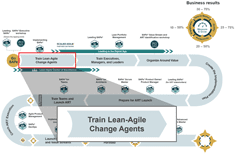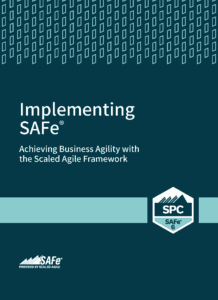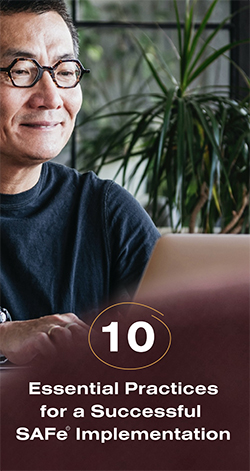
A strong guiding coalition is always needed. One with the right composition, level of trust, and shared objective.
—John Kotter
Train Lean-Agile Change Agents
This article is article two in the SAFe® Implementation Roadmap series. Click here to view the entire roadmap.
Reaching the Tipping Point describes that the need to adopt new practices for business agility and solution development is often driven by a burning platform—a problem too severe to solve using the enterprise’s current way of working. It creates the level of urgency needed to inspire significant change.
However, even if that is not the case, as the pace of technology advancements, market changes, and digital disruption reshapes the modern business model, this sense of urgency has become the new norm. Now more than ever, the ability to substantially improve development practices to enable more significant innovation, higher quality, and faster time-to-market is the key to success. Change is at hand. For those following the proven critical moves identified in the SAFe Implementation Roadmap, this article describes the second step in that series: train Lean-Agile change agents.
Details
The Need for a Powerful Coalition
Once an organization reaches its tipping point and the rationale for a significant change becomes evident, the arduous journey begins. In Accelerate, Kotter discusses eight stages for guiding organizational transformation and what it takes to make it stick [1].
- Create a sense of urgency
- Build a guiding coalition
- Form a strategic vision
- Enlist a volunteer army
- Enable action by removing barriers
- Generate short-term wins
- Sustain acceleration
- Institute change
Step 2 needs a ‘sufficiently powerful guiding coalition’ of stakeholders. As Kotter notes: “In a rapidly moving world, individuals and weak committees rarely have all the information needed to make good non-routine decisions. Nor do they seem to have the credibility or the time required to convince others to make the personal sacrifices called for in implementing changes. Only teams with the right composition and sufficient trust among members can be highly effective under these circumstances.” [1]
An effective coalition requires the following:
- Leaders who can set the vision, show the way, and remove impediments to change
- Practitioners, managers, and change agents who can implement specific process changes
- Sufficient organizational credibility to be taken seriously
- The expertise needed to make fast, intelligent decisions
Experience shows that the organization must take four critical steps to create a coalition that is sufficiently powerful to initiate this change:
- Train Lean-Agile change agents as Certified SAFe® Practice Consultants (SPCs). They provide the knowledge and horsepower needed to implement the change.
- Create a Lean-Agile Center of Excellence (LACE). This working group becomes the focal point and continuous source of inspiration and energy for change management activities.
- Train executives, managers, and other leaders. They sponsor the change and support the implementation. Leading SAFe® is a two-day course designed for this purpose. Leading in the Digital Age enables leaders throughout the organization to practice, within facilitated cohorts, the new mindset and behaviors needed.
- Enlist leaders to engage and ‘lead the change’ of implementing SAFe, as summarized by Lead in the Digital Age.
This article addresses the first step, introducing a process that develops people with the knowledge, skills, and resources needed to implement SAFe successfully. Elements 2 through 4 of the guiding coalition are addressed in the articles Create a Lean-Agile Center of Excellence, Train Executives, Managers, and Leaders, and Lead in the Digital Age.
Develop SPCs as Change Agents
In most enterprises, the primary SAFe change agents appear as certified SPCs. Sourced internally and externally, they come from many sources, including:
- Trusted consulting partners (find a Scaled Agile partner)
- Internal business and technology leaders
- Portfolio/program/project managers
- Trusted individual contributors with organizational credibility
Ideally, the change agent community includes individuals from various departments, disciplines, and experience levels. Generally, this includes pairing internally sourced personnel with more experienced external change agents from a Scaled Agile partner. Providing the transformation team with external SAFe coaches is strongly recommended. As described by engineer Destin Sandlin in the Backwards Bicycle video [2], “Knowledge is not understanding.” Experienced coaches provide the internal transformation team with the insights gained from many SAFe transformations and can help organizations avoid many of the most common implementation mistakes.
Deep knowledge of SAFe is still vital, and that learning journey begins with the Implementing SAFe® with SPC certification class. This four-day course prepares SPCs to become the change agents who lead the transformation. Attendees will learn how to apply the principles and practices of SAFe and organize, train, and coach Agile teams. They will also learn to identify Value Streams and Agile Release Trains (ARTs), launch ARTs, and help build and manage an Agile portfolio.
Scaling Lean-Agile across the enterprise—or making any material change for that matter—requires training all the people who do the work. Scaled Agile, Inc. (SAI) supports a train-the-trainer fan-out model to make it practical and cost-effective. SAI licenses SPCs (either partner personnel or enterprise employees) to teach SAFe courses inside the enterprise. This provides an affordable training strategy and provisions the trainers needed to initiate and implement the change.
More on Implementing SAFe® with SPC Certification
The goal of this intensive four-day course is to prepare internal change agents and external consultants to:
- Lead an enterprise Lean-Agile transformation
- Implement SAFe
- Train managers and executives in Leading SAFe®
- Launch Agile Release Trains
- Identify Value Streams
- Understand key roles within SAFe
The first two days of this class are an intensive version of Leading SAFe®. This is an immersive first step in preparing certified SPCs to teach Leading SAFe® and other courses in the SAFe role-based curriculum (see below).
The second two days demonstrate how to identify, plan, and implement SAFe. In addition, attendees will have the briefings, artifacts, and templates needed to identify value streams, prepare the organization, launch ARTs, plan and execute major events, and implement effective processes and measures to sustain and improve.
These change agents will gain the knowledge needed to lead an enterprise-wide Agile transformation by leveraging SAFe and its underlying principles of Agile development, systems thinking, and Lean product development flow. They’ll leave with an understanding of how the principles and practices of SAFe support Agile teams, ARTs, Lean Portfolio Management (LPM), and Agile Architecture.
After passing an exam, attendees become certified SPCs, giving them access to various helpful resources for the transformation. They will also gain access to online Trainer Enablement plans to qualify them to teach and certify others in Leading SAFe® as well as other courses in the role-based curriculum, such as:
- SAFe® for Teams with SP certification
- SAFe® Scrum Master with SSM certification
- SAFe® Advanced Scrum Master with SASM certification
- SAFe® Product Owner/Product Manager with POPM certification
- SAFe® DevOps with SDP certification
This curriculum is constantly evolving. For more, check out Implementing SAFe® with SPC certification and review the other courses at ScaledAgile.com.
Making the Next Moves
Once trained, SPCs have the knowledge, skills, and resources needed to educate and train managers, teams, and other stakeholders to drive the change effectively. They become a critical part of the sufficiently powerful coalition for the changes needed to drive the next essential moves, which include:
- Create a Lean-Agile Center of Excellence
- Train executives, managers, and leaders
- Leading in the Digital Age
- Organize Around Value
- Create the Implementation Plan
These are the subjects of the next set of articles in this series.
This article serves as a launching pad to explore these steps in detail and understand how to apply them to specific implementations.
Learn More
[1] Kotter, John P. Accelerate. Harvard Business Review Press, 2014.
[2] Sandlin, Destin. Backwards bicycle. https://youtu.be/MFzDaBzBlL0
[2] Knaster, Richard, and Dean Leffingwell. SAFe 5.0 Distilled, Achieving Business Agility with the Scaled Agile Framework. Addison-Wesley, 2020.
Last update: 22 November 2022

